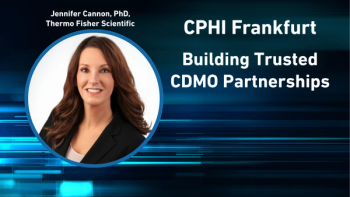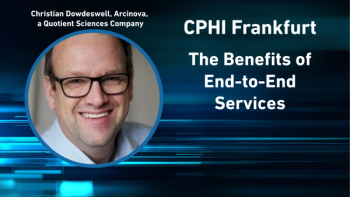
- Pharmaceutical Technology-02-01-2016
- Volume 2016 Supplement
- Issue 1
Preventing Phase III Failures
Only half of new drugs make it past Phase III. Adopting best practices and collaborating more closely with contract research organizations can help ensure success.
In the long road to drug development, Phase III is the ultimate reality check, where a new drug’s safety and efficacy, and the impact of a therapeutic dose, are measured in human beings. It is the point where manufacturing and operations become more involved in the process, where the drug is actually produced for use in clinical evaluation, and where manufacturers can, to a very limited extent, begin marketing the new drug.
Phase III clinical trials are designed to confirm results of Phase II trials, the goal of which is to demonstrate that a drug will have the desired effect. Half of late Phase III trials, however, fail to show sufficient efficacy or safety (e.g., for oncology drugs, the failure can be as high as 60%).
One of the reasons for this alarming failure rate is the tendency for manufacturers to rush to Phase III once an exciting signal shows up at Phase II, said Alberto Grignolo, corporate vice-president of the contract research organization (CRO), Parexel International Corp. at an October 2015 webcast on this topic (1). Subsequently, expectations may be crushed, he said, paraphrasing Thomas Huxley, as the “great tragedy of science” plays out, and a “beautiful hypothesis” is slain by “ugly facts.”
For the pharmaceutical industry, this tragedy has also become extremely wasteful, not only for companies, which, according to the Pharmaceutical Research and Manufacturers of America (PhRMA), spent an average of $42,000 per patient in Phase III trials ($59,520 for oncology drugs), but for patients, tens of thousands of whom may waste time taking part in studies that they hope will result in new cures for their ailments (2).
In 2013, PhRMA estimates that biopharmaceutical manufacturers spent $10 billion to run 1680 clinical trials involving 644,684 patients (2). At the webcast, Parexel’s Grignolo cited FDA analysis of drug applications submitted from 2000 to 2012 that was published in 2014 in the Journal of the American Medical Association. FDA’s research showed that, of 313 new molecular entity (NME) submissions received in 2013, only 151 were approved, and nearly half failed because they couldn’t show efficacy. More than 40% failed, the study found, because they had safety and efficacy problems (3).
Often, Phase III failure can be traced to flaws in the clinical study design or errors in determining the optimal dose. In the October 2015 webcast (1), Grignolo and Parexel’s Chief Science Officer, Sy Pretorius, examined the issues. A number of companies have developed best practices and rules of thumb to help ensure success, Pretorius noted, citing AstraZeneca’s “5R” approach, which involves ensuring that Phase III work is designed to confirm “Right Target, Right Tissue, Right Safety, Right Patients, and Right Commercial Potential.” A sixth R is “Right Culture,” he adds, in which teams are willing to admit failure early on and to evaluate test data in an open way (4).
Another model that Parexel suggests for the industry is Pfizer’s Three Pillar framework (5), which focuses on ensuring that test protocols and methods confirm exposure at target site, binding to target site, and expressions of pharmacology. Computer simulations, such as those used by Roche (6), can also be useful in evaluating a proposed protocol, while adapting live simulations (and role playing with mock physicians and patients), as Eli Lilly has done with its Jam Sessions (7), may yield results, Pretorius says, and ensure that a patient-focused approach is taken.
Pretorius and Grignolo noted that sponsors should comnicate proactively with regulators to get an understanding of their expectations. In addition, they note, sponsors should work closely with clinical research partners to ensure that their initial Phase III protocol drafts or synopses have been carefully reviewed from different points of view.
At Parexel, Pretorius notes, a multidisciplinary team examines the protocol, breaking it down by segment, and experts evaluate each segment based on regulatory issues, scientific methods, operations, and commercial goals. After evaluation, the CRO can then pose alternative scenarios and compare them to the original protocol based on cost and time required.
Collaborating for Success at Phase III
Both Grignolo and Pretorius shared their thoughts with Pharmaceutial Technology, on why Phase III studies fail so often, and what can be done about it.
PharmTech: Why do so many drugs fail at Phase III? What steps can be taken to help reduce failures at this point?
Pretorius: While there can be various drivers that lead to the failure of drugs during Phase III, the following represent what we find to be the top five, based on presentations given at a 2014 summit organized by the European Center for Pharmaceutical Medicine (ECPM):
- Basic science-Animal models that do not translate or are not entirely related to human disease, poor understanding of target disease biology, or drugs that are simply ineffective.
- Clinical study design-Changes in patient definitions (inclusion criteria and exclusion criteria) from Phase II to Phase III, insensitive outcomes measures or Phase II surrogate endpoints that are not confirmed by Phase III endpoints. Inappropriate study design can undermine the ability to show efficacy or the sample size may be too small.
- Dose selection-The dose may be inappropriate for Phase III. This can happen when investigators or sponsors become overenthusiastic about Phase II results and rush to Phase III without fully exploring dose finding. Inadequate therapeutic indices may also lead to suboptimal dosing.
- Data collection and analysis-False positive signals from Phase II and overly optimistic assumptions about variability and treatment differences may result in such problems as missing data, attrition bias, rater bias, errors in measurement methods, or inappropriate statistical methods.
- Operational execution-Data integrity issues or good clinical practice (GCP) violations may come into play if the protocol hasn’t been adequately designed. In addition, unexpected variations in recruitment or dropouts can affect results, as can protocol variations, missing data, or unintentional unblinding of subjects.
All of these problems can result in efficacy failures, safety failures, as well as commercial/financial failures. For instance, the drug may not meet the primary efficacy endpoint, may result in unexpected adverse or serious adverse events, or may fail to demonstrate value compared to existing therapy and standard of care.
Although there is no simple solution for preventing Phase III failures, several approaches are currently being developed to reduce the risk. These include:
- Applying more rigor to the overall development process-Applying more rigor and discipline to the development process holds potential for weeding out likely failures earlier in the process, thereby reducing Phase III failure rates (e.g., avoiding shortcuts such as truncated Phase I or Phase II studies in the interest of a rush to Phase III and the market, or not listening diligently and thoughtfully to the inputs of regulators prior to launching Phase III).
- Adequate Phase II testing-Many Phase III trials fail because of a fundamental lack of understanding of the mechanisms of action of NMEs. Rushing to get to Phase III without adequate understanding of critical components is risky and more often leads to unpleasant surprises in Phase III. Not only does this proposed approach in Phase II make intuitive sense, but it also holds potential for reducing late-stage failures.
- Optimizing Phase III study design-Strategies for success would include more disciplined protocol review and optimization, as well as use of modeling and simulation, adaptive trial designs, and biomarkers.
- De-risking Phase III execution-To mitigate study execution risks, pharma companies and CROs should leverage data from a variety of sources and conduct ongoing surveillance of the quality of data being collected, while tying this to a properly planned risk-based monitoring protocol.
- Ensure completeness and clarity of submissions for regulatory agencies-Pharma companies should seek advice from regulators during the drug development process. FDA offers sponsors and applicants the opportunity to schedule formal meetings at critical points in the development and regulatory process to discuss the plan and identify areas of concern that may need adjustment.
Regulatory agencies see a vast number of development programs that succeed and fail; their experience can bring significant benefit to sponsors who listen and learn from it.
Collaboration between sponsors and CROsPharmTech: How should pharma companies and CROs collaborate to avoid Phase III failure? What role should each play in developing a strategy?
Grignolo: Although Phase III failures cannot be eliminated, some strategies can provide sponsors a way of minimizing the risk of failure in their drug development plans. This risk assessment and mitigation should start early in the drug-development process.
Ultimately, pharmaceutical companies and CROs should collaborate to ensure they can anticipate potential threats and opportunities, have a defined governance structure in place, define success metrics, and communicate openly and frequently.
CROs, not unlike regulatory agencies, are aware of and active participants in numerous development programs across hundreds of diverse sponsors; this experience can be brought to bear on subsequent sponsors and can help them avoid expensive and time-eroding failures.
PharmTech: What special considerations should be given, up front, to pricing and payer expectations?
Pretorius: The use of prescription drugs, as a percentage of total healthcare spending, has increased dramatically over time, driven in large part by the enormous cost of innovation in the biopharmaceutical space. Payers, now more than ever, dictate whether an adequate return will be generated on this investment.
However, payers are under huge pressure to control their own costs, which drives a focus on demonstrating clear value to patients and the healthcare system. While this creates obvious challenges to a pharmaceutical company looking to commercialize a newly approved product, it also represents an opportunity to create a ‘win-win’ by identifying key value drivers early on in the development process, generating relevant clinical evidence and demonstrating this value to stakeholders in a compelling manner that supports the needs of patients, payers, physicians, and pharmaceutical companies.
In this new world, obtaining regulatory approval is no longer sufficient for drug developers to have a successful and profitable drug in the market. Today, companies must be able to demonstrate to payers and other stakeholders that their drug is worthy of being reimbursed at an attractive level and prescribed in the right situations.
To prepare for commercial needs, it is important to keep a focus on market access, payer and provider considerations throughout development, and specifically during Phase II and Phase III studies.
In particular, pharmaceutical manufcturers should keep the following goals in mind:
- Differentiated value proposition for the new drug vs. existing standard of care
- Personalized health care strategy, including diagnostics and biomarkers that enable the delivery of “precision medicine” to patients in a cost-effective manner.
References
1. Parexel International,
2. Battelle Labs (for PhRMA),
, accessed Jan. 26, 2016.
3. Sacks et al, Journal of the American Medical Association, 311: 378-384 (2014).
4. D. Cook, et al, Nature Reviews and Discovery, 13 419-431 (May 2014).
5. P. Morgan et al, Drug Discovery Today, 17 (9/10) pp. 419-424 (May 2012).
6.
7. “
Article DetailsPartnerships in Outsourcing Supplement
Vol. 40, No. 13
Pages: 24–27
Citation:
When referring to this article, please cite it as A. Shanley, “Preventing Phase III Failures," Pharmaceutical Technology Partnerships in Outsourcing Supplement 40 (13) 2016.
Articles in this issue
almost 10 years ago
Success Story: Transferring a Phytochemical API Portfolioalmost 10 years ago
The Impact of SEND on the Pharmaceutical Industryalmost 10 years ago
Under New Ownership: Consolidation Reshapes Contract Services Marketalmost 10 years ago
Quality Metrics and Best Practices for Working with Contract Labsalmost 10 years ago
Lab Services: To Outsource or Not to Outsourcealmost 10 years ago
Keeping It Simple: Collaborating for Success in Drug Deliveryalmost 10 years ago
Surveys Examine Outsourcing Trendalmost 10 years ago
Emerging Life-Sciences Markets: New Partnerships, New Competitorsalmost 10 years ago
UV Spectroscopy Gains Use in Dissolution Testingalmost 10 years ago
Pharmaceutical Technology, 2016 Partnerships in Outsourcing Supplement (PDF)Newsletter
Get the essential updates shaping the future of pharma manufacturing and compliance—subscribe today to Pharmaceutical Technology and never miss a breakthrough.





